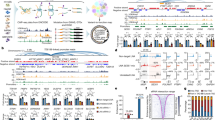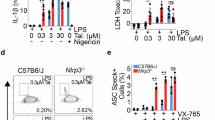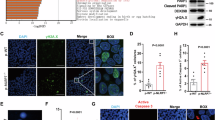Abstract
NLRP7 is a major gene responsible for recurrent hydatidiform moles. Here, we report 11 novel NLRP7 protein truncating variants, of which five deletions of more than 1-kb. We analyzed the transcriptional consequences of four variants. We demonstrate that one large homozygous deletion removes NLRP7 transcription start site and results in the complete absence of its transcripts in a patient in good health besides her reproductive problem. This observation strengthens existing data on the requirement of NLRP7 only for female reproduction. We show that two other variants affecting the splice acceptor of exon 6 lead to its in-frame skipping while another variant affecting the splice donor site of exon 9 leads to an in-frame insertion of 54 amino acids. Our characterization of the deletion breakpoints demonstrated that most of the breakpoints occurred within Alu repeats and the deletions were most likely mediated by microhomology events. Our data define a hotspot of Alu instability and deletions in intron 5 with six different breakpoints and rearrangements. Analysis of NLRP7 genomic sequences for repetitive elements demonstrated that Alu repeats represent 48% of its intronic sequences and these repeats seem to have been inserted into the common NLRP2/7 primate ancestor before its duplication into two genes.
Similar content being viewed by others
Log in or create a free account to read this content
Gain free access to this article, as well as selected content from this journal and more on nature.com
or
References
Savage P, Williams J, Wong SL et al: The demographics of molar pregnancies in England and Wales from 2000–2009. J Reprod Med 2010; 55: 341–345.
Grimes DA : Epidemiology of gestational trophoblastic disease. Am J Obstet Gynecol 1984; 150: 309–318.
Eagles N, Sebire NJ, Short D, Savage PM, Seckl MJ, Fisher RA : Risk of recurrent molar pregnancies following complete and partial hydatidiform moles. Hum Reprod 2015; 30: 2055–2063.
Sebire NJ, Fisher RA, Foskett M, Rees H, Seckl MJ, Newlands ES : Risk of recurrent hydatidiform mole and subsequent pregnancy outcome following complete or partial hydatidiform molar pregnancy. BJOG 2003; 110: 22–26.
Horn LC, Kowalzik J, Bilek K, Richter CE, Einenkel J : Clinicopathologic characteristics and subsequent pregnancy outcome in 139 complete hydatidiform moles. Eur J Obstet Gynecol Reprod Biol 2006; 128: 10–14.
Kronfol NM, Iliya FA, Hajj SN : Recurrent hydatidiform mole: a report of five cases with review of the literature. J Med Liban 1969; 22: 507–520.
Vargas R, Barroilhet LM, Esselen K et al: Subsequent pregnancy outcomes after complete and partial molar pregnancy, recurrent molar pregnancy, and gestational trophoblastic neoplasia: An update from the New England Trophoblastic Disease Center. J Reprod Med 2014; 59: 188–194.
Murdoch S, Djuric U, Mazhar B et al: Mutations in NALP7 cause recurrent hydatidiform moles and reproductive wastage in humans. Nat Genet 2006; 38: 300–302.
Parry DA, Logan CV, Hayward BE et al: Mutations causing familial biparental hydatidiform mole implicate c6orf221 as a possible regulator of genomic imprinting in the human oocyte. Am J Hum Genet 2011; 89: 451–458.
Kou YC, Shao L, Peng HH et al: A recurrent intragenic genomic duplication, other novel mutations in NLRP7 and imprinting defects in recurrent biparental hydatidiform moles. Mol Hum Reprod 2008; 14: 33–40.
Wang CM, Dixon PH, Decordova S et al: Identification of 13 novel NLRP7 mutations in 20 families with recurrent hydatidiform mole; missense mutations cluster in the leucine-rich region. J Med Genet 2009; 46: 569–575.
Hayward BE, De Vos M, Talati N et al: Genetic and epigenetic analysis of recurrent hydatidiform mole. Hum Mutat 2009; 30: E629–E639.
Slim R, Bagga R, Chebaro W, Srinivasan R, Agarwal N : A strong founder effect for two NLRP7 mutations in the Indian population: an intriguing observation. Clin Genet 2009; 76: 292–295.
Qian J, Cheng Q, Murdoch S et al: The genetics of recurrent hydatidiform moles in China: correlations between NLRP7 mutations, molar genotypes and reproductive outcomes. Mol Hum Reprod 2011; 17: 612–619.
Estrada H, Buentello B, Zenteno JC, Fiszman R, Aguinaga M : The p.L750V mutation in the NLRP7 gene is frequent in Mexican patients with recurrent molar pregnancies and is not associated with recurrent pregnancy loss. Prenat Diagn 2013; 33: 205–208.
Akoury E, Gupta N, Bagga R et al: Live births in women with recurrent hydatidiform mole and two NLRP7 mutations. Reprod Biomed Online 2015; 31: 120–124.
Khare S, Dorfleutner A, Bryan NB et al: An NLRP7-containing inflammasome mediates recognition of microbial lipopeptides in human macrophages. Immunity 2012; 36: 464–476.
Messaed C, Akoury E, Djuric U et al: NLRP7, a nucleotide oligomerization domain-like receptor protein, is required for normal cytokine secretion and co-localizes with Golgi and the microtubule-organizing center. J Biol Chem 2011; 286: 43313–43323.
Mahadevan S, Wen S, Wan YW et al: NLRP7 affects trophoblast lineage differentiation, binds to overexpressed YY1 and alters CpG methylation. Hum Mol Genet 2014; 23: 706–716.
Nguyen NM, Zhang L, Reddy R et al: Comprehensive genotype-phenotype correlations between NLRP7 mutations and the balance between embryonic tissue differentiation and trophoblastic proliferation. J Med Genet 2014; 51: 623–634.
Akoury E, Zhang L, Ao A, Slim R : NLRP7 and KHDC3L, the two maternal-effect proteins responsible for recurrent hydatidiform moles, co-localize to the oocyte cytoskeleton. Hum Reprod 2015; 30: 159–169.
Reddy R, Akoury E, Phuong Nguyen NM et al: Report of four new patients with protein-truncating mutations in C6orf221/KHDC3L and colocalization with NLRP7. Eur J Hum Genet 2013; 21: 957–964.
Cai C, Tamai K, Molyneaux K : KHDC1B is a novel CPEB binding partner specifically expressed in mouse oocytes and early embryos. Mol Biol Cell 2010; 21: 3137–3148.
Tian X, Pascal G, Monget P : Evolution and functional divergence of NLRP genes in mammalian reproductive systems. BMC Evol Biol 2009; 9: 202.
Ulker V, Gurkan H, Tozkir H et al: Novel NLRP7 mutations in familial recurrent hydatidiform mole: are NLRP7 mutations a risk for recurrent reproductive wastage? Eur J Obstet Gynecol Reprod Biol 2013; 170: 188–192.
Messaed C, Chebaro W, Di Roberto RB et al: NLRP7 in the spectrum of reproductive wastage: rare non-synonymous variants confer genetic susceptibility to recurrent reproductive wastage. J Med Genet 2011; 48: 540–548.
Kohany O, Gentles AJ, Hankus L, Jurka J : Annotation, submission and screening of repetitive elements in Repbase: RepbaseSubmitter and Censor. BMC Bioinformatics 2006; 7: 474.
Dixon PH, Trongwongsa P, Abu-Hayyah S et al: Mutations in NLRP7 are associated with diploid biparental hydatidiform moles, but not androgenetic complete moles. J Med Genet 2012; 49: 206–211.
Slim R, Ao A, Surti U et al: Recurrent triploid and dispermic conceptions in patients with NLRP7 mutations. Placenta 2011; 32: 409–412.
Huang JY, Su M, Lin SH, Kuo PL : A genetic association study of NLRP2 and NLRP7 genes in idiopathic recurrent miscarriage. Hum Reprod 2013; 28: 1127–1134.
Jurka J, Kohany O, Pavlicek A, Kapitonov VV, Jurka MV : Duplication, coclustering, and selection of human Alu retrotransposons. Proc Natl Acad Sci USA 2004; 101: 1268–1272.
Batzer MA, Deininger PL : Alu repeats and human genomic diversity. Nat Rev Genet 2002; 3: 370–379.
Sen SK, Han K, Wang J et al: Human genomic deletions mediated by recombination between Alu elements. Am J Hum Genet 2006; 79: 41–53.
Konkel MK, Walker JA, Batzer MA : LINEs and SINEs of primate evolution. Evol Anthropol 2010; 19: 236–249.
Deininger PL, Batzer MA : Alu repeats and human disease. Mol Genet Metab 1999; 67: 183–193.
Flynn EK, Kamat A, Lach FP et al: Comprehensive analysis of pathogenic deletion variants in Fanconi anemia genes. Hum Mutat 2014; 35: 1342–1353.
Hedges DJ, Deininger PL : Inviting instability: Transposable elements, double-strand breaks, and the maintenance of genome integrity. Mutat Res 2007; 616: 46–59.
Acknowledgements
We thank the patients and their family for their cooperation. The authors wish to acknowledge the use of the Sequencing platform of the McGill University and Génome Québec Innovation Centre. NMPN was supported by a Max E. Binz Fellowship from the McGill University Faculty of Medicine. The study was supported by the Canadian Institute of Health Research grants, MOP-86546 and PPP-122897, to RS.
Author information
Authors and Affiliations
Corresponding author
Ethics declarations
Competing interests
The authors declare no conflict of interest.
Additional information
Supplementary Information accompanies this paper on European Journal of Human Genetics website
Rights and permissions
About this article
Cite this article
Reddy, R., Nguyen, N., Sarrabay, G. et al. The genomic architecture of NLRP7 is Alu rich and predisposes to disease-associated large deletions. Eur J Hum Genet 24, 1445–1452 (2016). https://doi.org/10.1038/ejhg.2016.9
Received:
Revised:
Accepted:
Published:
Issue date:
DOI: https://doi.org/10.1038/ejhg.2016.9
This article is cited by
-
Recurrent Androgenetic Complete Hydatidiform Moles with p57KIP2-Positive in a Chinese Family
Reproductive Sciences (2022)
-
A novel large fragment deletion in PLS3 causes rare X-linked early-onset osteoporosis and response to zoledronic acid
Osteoporosis International (2017)
-
Two novel mutations in the KHDC3L gene in Asian patients with recurrent hydatidiform mole
Human Genome Variation (2016)



